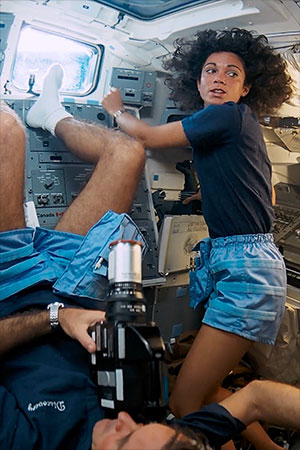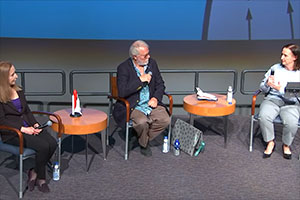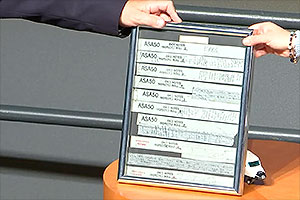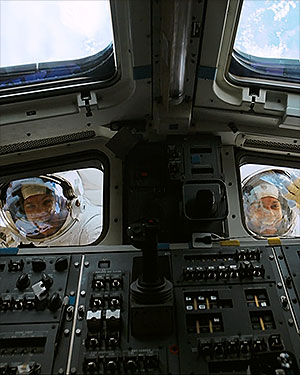April 11, 2025 — James Neihouse had one more thing to share. From inside a tote bag, he pulled out a chrome frame displaying 11 strips of tape, each of which had printed text and handwritten notes.
These were labels removed from film cans, the award-winning cinematographer explained. But not just from any film — these were the 41-year-old labels from the third space shuttle mission to carry an IMAX camera into Earth orbit. The rolls were used in the making of the first movie to include scenes shot in space, as first released four decades ago this June.
"So this is from nine rolls of film on STS-41G. This is all astronaut handwriting on this," said Neihouse at the end of a panel discussion celebrating the upcoming 40th anniversary of "The Dream is Alive" at the National Air and Space Museum's Steven F. Udvar-Hazy Center in northern Virginia on Wednesday (April 9).
The 37-minute documentary about NASA's space shuttle program includes footage shot by the astronauts showing how they live and work in orbit, including the capture and repair of the Solar Max satellite and deployment of an experimental solar array. Veteran journalist and TV news anchor Walter Cronkite narrated the film.
"I've hung on to this for about 40 years," said Neihouse, referring back to the framed tape strips. "I'm giving it to the Smithsonian, hopefully to go with the IMAX camera that they already have."
Presented as a public service
The National Air and Space Museum's connection to "The Dream is Alive" extends beyond the related artifacts in the national collection. The original idea for shooting a giant screen film in space began with a conversation between the museum's first director, an Apollo 11 astronaut, and the co-inventor of the IMAX film format, a Canadian filmmaker.
"One of the things about the film that most people probably don't know is that it's a direct result of a suggestion to Graeme Ferguson from Michael Collins after the National Air and Space Museum opened in 1976," Neihouse told collectSPACE in an interview prior to the panel discussion, which was organized by the National Air and Space Society for its members. "Collins suggested to Graham to see about flying an IMAX camera on board the space shuttle."
"And Graeme said, 'That sounds like a really great idea — what's a space shuttle?'" Neihouse said with a laugh as he imitated Ferguson's Canadian accent.
It was also Collins' idea for the museum to have an IMAX theater and it became only the sixth such theater to open in the United States. From there, it led to the Smithsonian becoming directly involved in the production of "The Dream is Alive," as well as the two shot-in-space IMAX movies that followed it ("Blue Planet" in 1990 and "Destiny in Space" in 1994).
"Collins saw the effect that IMAX films had on our visitors and he realized that a film made in space would amplify the storytelling about astronaut life there," said the panel's moderator Jennifer Levasseur, who as a curator in the space history division of the National Air and Space Museum oversees the museum's collection of cameras used in space. "He and others lobbied for such a film, and with Lockheed financing it, NASA couldn't resist."
"These films weren't developed as promotional materials for NASA, but really as a means for everyone involved in the space program to communicate, educate and inspire," said Levasseur.
The closest you could come
"The Dream is Alive" was described as the closest that the public could come to experiencing spaceflight without leaving the planet.
"Those of us who have filmed IMAX in space and who have flown in space have always said that, and it's not just to repeat the sound bite, it's actually true," said Marsha Ivins, a former NASA astronaut who flew into space five times and holds the record for taking part in the most IMAX space films (at three) and advised on the production of others.
Selected as an astronaut in 1984, Ivins was filmed for "The Dream is Alive" during her and her classmates' water survival training at Homestead Air Force Base (today, Air Reserve Base) in Florida, but her scenes did not make it into the movie.
"So they tossed me off the back of a boat, and I'm trying not to drown, and while I'm trying not to drown and remember all the things they told me to do to not drown, here comes this boat right alongside with the film crew," said Ivins. "And while I was not drowning, I did have the presence of mind to express myself with a hand gesture."
"And at the end of it, [associate producer] Phyllis Ferguson comes to me and says, 'We really wanted to put you in the movie, but everything we shot of you was either pathetic or obscene' — and a great relationship with IMAX was born that lasted to this day," Ivins said with smile.
Keeping 'The Dream' alive
Wednesday's event concluded with a rare screening of "The Dream is Alive." With the move to digital, high-resolution projectors, the 40-year-old film really needs to be rescanned, a project that Neihouse is now championing.
"The parts of the [space-flown] film that made it into what you see on screen are conserved in climate controlled storage in Los Angeles, as are all of our original space negatives," said Neihouse. "In theory, you could go back and pull any of that IMAX footage, scan it into whatever resolution your digital system is today and have a pristine digital version of the film."
"A lot of the of the films that are extremely important, such as the space films, are being scanned. I know 'The Dreams is Alive' is, as that's something I'm heading up on the committee to work on that for the giant screen film industry," he said. |
|

A scene from the 1985 IMAX film "The Dream is Alive" showing the crew of space shuttle Discovery floating aboard the orbiter's flight deck helped engage the public in astronauts' lives in orbit. (IMAX)

National Air and Space Museum curator Jennifer Levasseur (at right) moderated a panel discussion with astronaut Marsha Ivins (at left) and cinematographer James Neihouse to celebrate the 40th anniversary of the IMAX film "The Dream is Alive" at the Steven F. Udvar-Hazy Center in northern Virginia on April 9, 2025. (NASM)

IMAX cinematographer James Neihouse gave to the Smithsonian his framed collection of film roll labels from the third space shuttle mission to fly an IMAX camera, as used in the making of the 1985 giant screen documentary, "The Dream is Alive." (NASM)

Astronauts Kathy Sullivan and David Leestma surprised filmmakers by unexpectedly showing up in the space shuttle's windows during a spacewalk when the film for the 1985 IMAX movie "The Dream is Alive" was being reviewed on the ground. (IMAX) |
